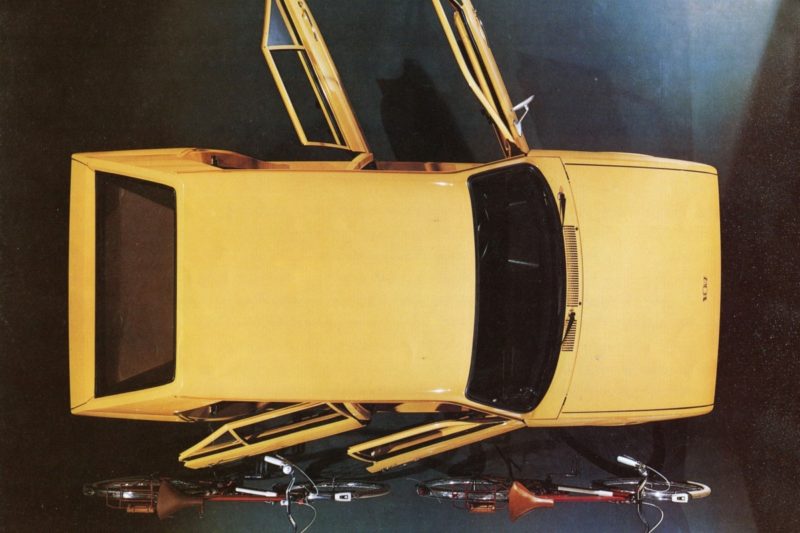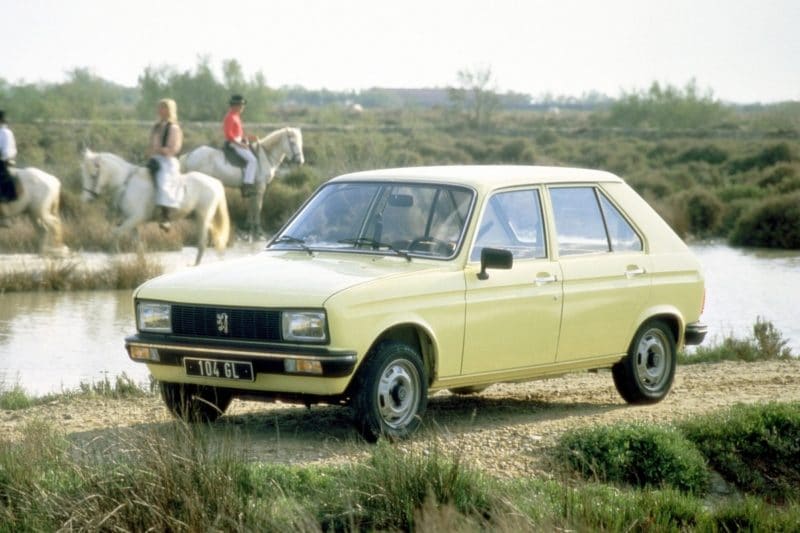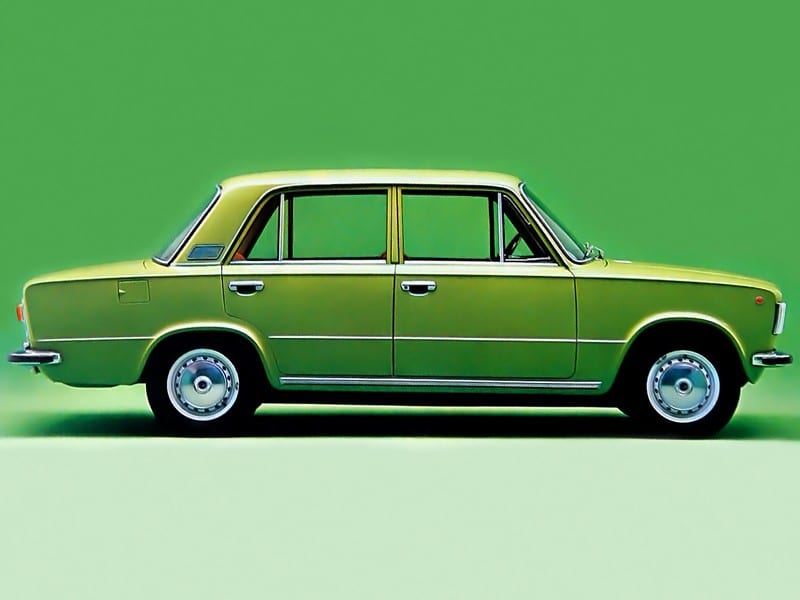A number of cars are celebrating their fiftieth anniversary this year. That's a decent number, because 1972 brought a lot of new car models. Traditionally, we put a number of newcomers from the past in the spotlight. Today we present part three. In it we briefly describe the Peugeot 104, the Fiat 124 Special T 1600 and the first BMW 5-series.
Peugeot 104
At its presentation in 1972, it was the smallest four-door car of that time: the Peugeot 104. Sochaux presented an attractive and individually constructed car, which gave its own interpretation to the concept of Supermini. The Peugeot 104 was characterized by a fairly high structure and angular shapes, which, partly thanks to the wheels placed on the corners, accommodated a lot of space. The 104 got the 72 degrees tilted and transversely placed 954 cc variant of the Moteur-X under the hood. The transmission and engine shared the crankcase, the overhead camshaft was driven by means of a chain. Of course - because very modern - the 104 got front-wheel drive. The four-door version (available as L and GL) was joined in 1973 by the shorter three-door version. This 104 Z initially got the 954 cc engine. Later, for example, the small three-door Z was also available as a ZS with the 1124 cc engine and as a ZS2 with the 1360 cc engine, which was also installed in the five-door 1980 S from model year 104.
Innovations in 1976
We go back in time for a while. From 1976 the 104 got the application that no manufacturer in this class could ignore: the large tailgate hinged in the roof. Initially Peugeot had the idea that a five-door 104 would put pressure on the sales of the 204 Estate, so for a while they stuck to the principle of four doors and a small tailgate for the separate trunk. When the Peugeot 204 disappeared in 1976, Peugeot did have room for a fifth door on the 104. That step resulted in an adapted range. The 104 GL became the entry-level model. The 204 was then replaced by the 104 GL6 (the number six stands for the number of French fiscal horsepower). Like the new SL, it got the 1124 cc engine (XW) and the rectangular headlights and grille of the three-door coupé. Also the short 104 was extended. The already mentioned ZS appeared on the menu in the mid-seventies. Later, for example, the ZL and ZR were added.
More changes until the end
Peugeot continued to modify the 104. So he got another dashboard. Furthermore, Peugeot adapted the front and rear of the short three-door and the longer five-door versions a few times. It also added equipment levels (or changed their names), expanded the engine range with the 1219 cc Douvrin engine and deleted versions. So there was enough movement in the range. That lasted until 1988, when the last 104 rolled off the line. Total production of the 104 was 1.6 million units. Those were not R5 or Peugeot 205 figures, but it can just as well be stated that the striking Peugeot 104 did not do any harm. It is not for nothing that the 104 became a long-runner within the Peugeot range of yesteryear.
Fiat 124 Special T 1600
1972 was a very busy introduction year for Fiat. The Italians launched numerous new models, extensions to existing models and new applications. The 1592 cc engine with a double overhead camshaft belongs to the latter category. The 132A engine replaced the 1608 cc TwinCam (Bialbero) engine from Lampredi, which was used in the 124 Coupé and Spider and in the 125 in several guises. The short The 1592 cc engine was developed especially for the new Fiat 132, but also found its way to the Lancia Beta, for example, and from 1973 also in the already mentioned 124 Coupé and Spider. Power and performance depended on model and version. The Fiat 132 received a lukewarm reception after its launch in the spring of 1972 and, in the eyes of many, could not make the 125 forget. Partly for this reason, Fiat brought another model in which the illustrious new double cam was mounted,
New 1592 cc engine also for Fiat 124 Special T
The Fiat 124 Berlina had already been running for six years in 1972, but the mass manufacturer from Turin still saw enough stretch in the successful 124 model. The Berlina top version was the Special T (with the T from TwinCam). From its introduction in November 1970 it had the 1438cc double overhead camshaft. But in 1972 Fiat announced the 124 Special T 1600. With this car, Fiat filled, among other things, the technical gap that had arisen with the disappearance of the 125. Like some other models from the Fiat stables, it got the new 1592 cc Fiat TC engine from Lampredi. The engine generated 124 DIN horsepower in the 95 Special T. The maximum torque was 125,5 Nm at 4000 rpm. A top speed of 170 kilometers per hour was possible. The fuel was supplied by a WEBER double downdraft carburettor. The car had power disc brakes all round, the Special interior and a rev counter. A four-speed gearbox with a final drive of 3,900:1 was standard, a five-speed gearbox was available at an extra cost. Whichever transmission you chose: the 124 Special T with 1592 cc engine was definitely not to be missed. Especially in this configuration it was a fantastic and polished family sedan, which gave the 124 Berlina series a new dimension. And that's something we don't need to explain to those who have had this particular Fiat in their hands. He was only on the program for a few years, but became illustrious and got under the skin. Today it is a very rare and therefore sought-after classic Fiat from an era that nothing was impossible with Fiat.
BMW 5 Series (E12)
In 1972, after an 5-year run, BMW replaced the entire Neue Klasse series with the new BMW 12-series, which debuted as the E12 series. Paul Bracq was responsible for the final design of the E5. BMW had meanwhile become quite a prestigious brand and with the new business middle class BMW formulated a strong, slim and business asset. The smooth-drawn 12-series for its time was a rear-wheel drive in the best BMW tradition. The EXNUMX was delivered exclusively as a four-door sedan.
Initially only with M10 engines, later also with beautiful six-cylinders
The first E12 models were delivered with M10 two-liter four-cylinder engines without and with injection. (520/520i). The 518 followed later (with the engine that was already known from the BMW 1800 and 1802). BMW expanded the 5-series program further with six-cylinder versions: the 525 and the 528. They both got the M30 engine, and that was a big step from a prestigious point of view. In 1977 the 520i appeared with the M20 six-cylinder engine and also got the 528 fuel injection. All cars had a four-speed gearbox and front disc brakes as standard. The larger six-cylinder models also received rear disc brakes. Depending on the model and period, BMW also made a five-speed gearbox (optional) available. In addition, buyers could also order a three-speed automatic transmission in combination with most versions. The more heavily motorized versions (520i, 525 and 528/528i) received reinforced stabilizers at the front and rear until 1979.
BMW Motorsport GmbH and CKD Packages for South Africa
After the summer of 1976, a slightly modified E12 series appeared. Most notable was the placement of new rear light units. Furthermore, BMW changed the E12 at a detailed level. The 5-series was also a reason for BMW Motorsport GmbH to build peppery versions with three-liter and 3.5 liter engines. Furthermore, Alpina knew what to do with the E12 basis, and built its own cars under this name, including those based on the 5-series. Regular production largely took place in Dingolfing (in the former and renovated glass factories). BMW also shipped CKD packages to South Africa, where the E12 was then built until 1985. From 1981, the E12 versions were equipped there with the interior of the E28 launched during that year. That became the actual successor of the E12, which ensured that the 5-series became the heart of the BMW range. And that is still the case today.
Also read:
- About all the benefits you have as an AMK subscriber
- Half a century young. The New Cars of 1972. Part One
- Half a century young. The New Cars of 1972. Part Two


















I've considered it, I understand the suggestion. But then I could also have mentioned the Samba, for example. In the end I made the choice to stick to the 104. And with the Peugeot brand.
Too bad Erik that you don't link with the in the P104 part as well Citroën LN(A); actually the 104 coach with Visa boxer, later the same water-cooled 1154cc.
At the time shamed by the real Citroën, because a Peus with Chevrons remains a Peus...now a collector's item.
'The real Citrophil'...rotten autocorrect...
The 104 engine, tilted version, still served as a model for the first 4-cylinder BMW motorcycle engine, . The combi box-motor was released, the block was placed completely horizontal and there it was: what was to be the successor of the boxers, but did not become, however, the successful K100 motorcycle.